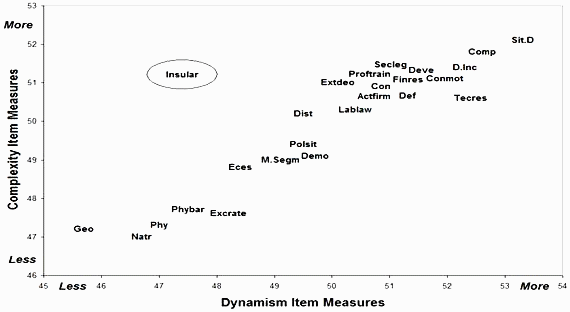
Organizations are in continuous interaction with their environment - an environment that is a primary source of opportunities and threats. Detailed information about that environment is required for making sound decisions, but that information is never complete. There is always uncertainty. Perceived Environmental Uncertainty (PEU) quantifies the lack of information about the world around a firm as perceived by its decision-makers.
The lack of information can be because the decision-related items, i, are difficult to understand (complexity, Ci) and because their nature is changing (dynamism, Di). This suggests a conceptual plot PEU. Any point on the plot gives the PEU experienced by a decision-maker based on the perceived complexity and dynamism of that environmental item.
 |
The core idea is to measure environmental complexity and dynamism by means of latent variables (empirically defined by operational items) without introducing any external weights as was done in previous research (e.g., Daft et al., 1988). Accordingly, we obtained a sample of 338 surveys answered by business managers in the Canary Islands (Spain). We asked them about their perceptions (on a 5-point scale) of complexity and dynamism for 25 items relevant to the local economy.
Cross-plotting the Rasch item calibrations for the complexity and dynamism constructs yields an instructive map of PEU, shown above. There is a strong correlation (R² = 0.85) between the two constructs. This confirms the findings of previous research (Daft et al., 1988). According to the scatterplot, dynamism and complexity contribute roughly equally to PEU. This finding differs from Duncan (1972). He found that dynamism contributes more to uncertainty.
 |
The "Insularity" item is an outlier (top left). It is perceived to be more complex than dynamic. This could be because of a special meaning of the term "insularity" for people living on islands. In one sense it is a constant factor in managing their businesses.
One way in which this work advances this field of research is that the relationship between complexity and dynamism derives from the decision-makers themselves and is not forced into the data by some arbitrary weighting system.
Another way is that it assists organizations faced by the problem of allocating resources for the improvement of decision-making. This methodology identifies which environmental items are perceived to be more uncertain and whether that uncertainty is more due to complexity or dynamism. This information can then be used to optimize decision support systems.
From Yanes-Estévez V., Oreja-Rodríguez J.R. & Alvarez P. (2004) Computing the perceived environmental uncertainty function by Rasch model, WSEAS Transactions on Business and Economics, 4, 1, 281-285
Daft R.L., Sormunen, J., Parks, D. (1988) Chief executive scanning, environmental characteristics, and company performance: an empirical study. Strategic Management Journal, 9, 123-139.
Duncan, R. (1972) Characteristics of organizational environment and perceived environment uncertainty, Administrative Science Quarterly, 17, 313 - 327.
Yanes-Estévez V., Oreja-Rodríguez J.R. & Alvarez P. (2006) Mapping Perceived Environmental Uncertainty, … Rasch Measurement Transactions, 2006, 19:3 p. 1033-4
| Forum | Rasch Measurement Forum to discuss any Rasch-related topic |
Go to Top of Page
Go to index of all Rasch Measurement Transactions
AERA members: Join the Rasch Measurement SIG and receive the printed version of RMT
Some back issues of RMT are available as bound volumes
Subscribe to Journal of Applied Measurement
Go to Institute for Objective Measurement Home Page. The Rasch Measurement SIG (AERA) thanks the Institute for Objective Measurement for inviting the publication of Rasch Measurement Transactions on the Institute's website, www.rasch.org.
| Coming Rasch-related Events | |
|---|---|
| Jan. 16 - Feb. 13, 2025, Fri.-Fri. | On-line workshop: Rasch Measurement - Core Topics (E. Smith, Winsteps), www.statistics.com |
| Apr. 8 - Apr. 11, 2026, Wed.-Sat. | National Council for Measurement in Education - Los Angeles, CA, ncme.org/events/2026-annual-meeting |
| Apr. 8 - Apr. 12, 2026, Wed.-Sun. | American Educational Research Association - Los Angeles, CA, www.aera.net/AERA2026 |
| May. 15 - June 12, 2026, Fri.-Fri. | On-line workshop: Rasch Measurement - Core Topics (E. Smith, Winsteps), www.statistics.com |
| June 19 - July 25, 2026, Fri.-Sat. | On-line workshop: Rasch Measurement - Further Topics (E. Smith, Winsteps), www.statistics.com |
The URL of this page is www.rasch.org/rmt/rmt194a.htm
Website: www.rasch.org/rmt/contents.htm